Abstract
There are numerous studies on the effects of ocean turbulence on wireless optical communications and on satellite–ground quantum key distribution (QKD); however, there are few studies on the impact of near sea-surface turbulence on ship-based QKD performance. This study investigates the influence of sea-surface atmospheric turbulence on laser beam propagation, atmospheric scintillation, and aiming error. It focuses on the impact of sea-surface turbulence on the performance of satellite-to-ship QKD and ship-to-ship QKD systems. The results show that strong turbulence severely degrades QKD system performance; horizontal transmission distances change from 32 km (weak turbulence) to 3 km (strong turbulence) in ship-to-ship QKD.
1. Introduction
Quantum communication technology is divided into fiber-optic quantum communication and free-space quantum communication due to different transmission channels. Currently, it is difficult to further expand the transmission distance of fiber optic quantum communication due to its inherent transmission loss. Free-space quantum communication is considered the best choice for realizing a global quantum communication network due to its advantages, such as low channel loss and the possibility of relaying through space platforms. Among them, quantum key distribution (QKD) has been widely studied and applied because of its high security [1,2,3,4,5]. Despite these advancements, maritime QKD applications remain under-explored. This is mainly because optical signals transmitted at the sea-surface are susceptible to refractive index fluctuations induced by ocean turbulence, leading to light intensity scintillation, beam drift and wave-front distortion, which degrade communication performance [6,7,8]. In wireless optical communications under ocean turbulence, the bit error rate (BER) performances of M-ary phase shift keying, subcarrier intensity modulation [9], M-ary pulse position modulation [10], average BER and interruption probability [11], and double-headed pulse interval modulation [12] have been investigated. However, the specific impacts on QKD systems operating in maritime environments remain poorly understood. In addressing this gap, our study quantifies the performance degradation of ship-based QKD under atmospheric turbulence of different intensities, providing favorable support for building a global quantum network [13,14].
2. The Influence of Sea-Surface Turbulence on Laser Beams and Aiming Error
The formation of sea-surface atmospheric turbulence is a complex process involving the interaction of multiple dynamic and thermodynamic conditions. Unlike inland atmospheric turbulence, oceanic atmospheric turbulence exhibits a clear pattern of daily variation, reaching extreme values in the late afternoon, and turbulence intensity tends to decrease with increasing altitude [15,16,17]. The atmospheric refractive index structure constant is usually used to characterize the magnitude of turbulence intensity, with larger values representing better atmospheric conditions. It varies from 10−12 (strong turbulence) to 10−17 (weak turbulence), with a mean value of 10−15. Its relationship with altitude is shown in the following equation:
where is the height in meters, is the ground structure constant , and is the root mean square wind speed measured in meters per second.
The change in oceanic atmospheric turbulence with seasons is not obvious, and the turbulence intensity in winter is slightly larger than that in summer; however, the spatial fluctuation is not significant. In general, the refractive index structure constants of offshore atmospheric turbulence at the surface range from 10−17 to 10−13 [15].
When a laser beam passes through a turbulent atmosphere, atmospheric turbulence causes the refractive index of light to change, resulting in beam intensity fluctuations, beam phases (up and down), beam drift and spread, and image point jitters. If the light intensity is measured in a turbulent atmosphere at some distance from the light source, it is found to fluctuate randomly around the mean value over time. This is due to the fact that the received laser is disturbed by atmospheric turbulence; alternating enhanced and weakened interference fringes appear in the transmission path, resulting in fluctuations in the detected radiation intensity. The scintillation index can describe the magnitude of this variation, and the model of atmospheric scintillation in the downlink can be expressed as:
A more precise Gaussian beam expression is needed for the uplink as follows:
where is the wave numbers, and is the zenith angle. The main difference in the scintillation model between the uplink and downlink is that the uplink needs to take into account variation in the atmospheric refractive structure constant; in other words, atmospheric scintillation has a greater impact on the uplink, as shown in Figure 1.
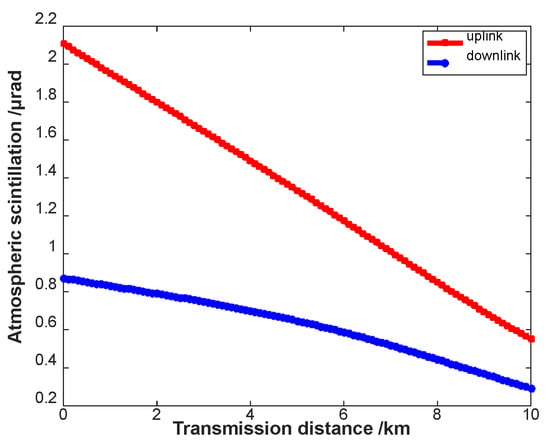
Figure 1.
Atmospheric scintillation versus transmission distance.
The variance of aiming error angles from light intensity flicker can be expressed as:
where is the scintillation constant; and are the wavelength and girdle radius of the laser beam, respectively; and is the atmospheric coherence length. In Figure 2, we can see that the variance in aiming error angle of the uplink caused by light intensity scintillation changes with altitude, and the higher the altitude, the smaller the aiming deviation caused by light intensity scintillation; the closer it is to sea level, the more obvious the effect of atmospheric turbulence on the beam; with an increase in altitude, the atmosphere gradually becomes thinner, caused by turbulence changes in the refractive index of the atmosphere becoming smaller; therefore, the aiming angle caused by the change is also smaller.
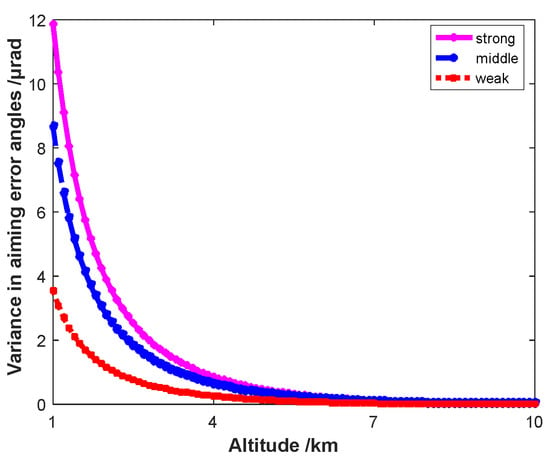
Figure 2.
Variance in aiming error angles versus altitude.
3. The Influence of Sea-Surface Turbulence on the Performances of a Ship-Based QKD
In a ship-based QKD system based on the BB84 protocol, performance is affected by sea-surface atmospheric turbulence. Moreover, the downlink is expected to experience lower attenuation since the uplink beam is much more affected by atmospheric turbulence [5,18]. If the uplink can accomplish communication, the downlink can also realize communication. Therefore, this study focuses on the performances of the uplink of a ship-based QKD system. Two kinds of ship-based QKD systems are studied in this paper: one where transmitter is on a ship and the receiver is on a satellite, and one where; both the transmitter and receiver are on ships. The specific schematic diagram is in Figure 3 as follows:
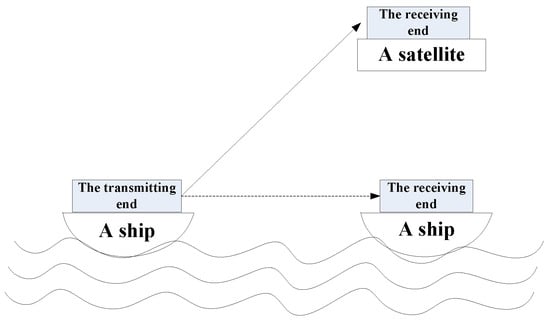
Figure 3.
Schematic diagram of QKD system based on a ship.
For a BB84-based system, the default parameter settings are as follows: the pulse repetition frequency at the transmitting end is 625 M; the number of individual pulse photons is 0.8; the diameter of the telescope at the transmitting end is 0.2 m; the transmitting end shading loss is 0.3; the diameter of the telescope at the receiving end is 0.6 m, the shading loss at the receiving end is 0.18; the wavelength is 1550 nm; the girdle radius of the laser beam is 0.005 m; the sifted efficiency of the BB84 protocol is 0.5; and the field-of-view angle is 100 μrad. To minimize the effect of background light on quantum light performance, the background parameter was set to that of a clear night.
3.1. The Satellite-to-Ship QKD System
In the satellite-to-ship QKD system, the transmitting end is fixed on a ship, and the receiving transmitting end is fixed on a satellite. Figure 4 shows the relationship between photon counts and the zenith angle when the satellite orbit altitude is 400 km. It can be seen that photon counts reach a maximum value at a zenith angle of 12 degrees; when the zenith angle is greater than 30 degrees, the photon count is very small. This is mainly due to the influence of atmospheric attenuation and geometric loss of light, limiting its transmission distance. In other words, the QKD system has a limited communication distance in the same orbital altitude, and the transmission distance varies with the zenith angle. Only the system in which the corresponding zenith angle is within the communication distance limit can be coded. This is why photon counts increase and then decrease as the zenith angle increases. When the zenith angle corresponding to the distance limit is exceeded, it is impossible to code.
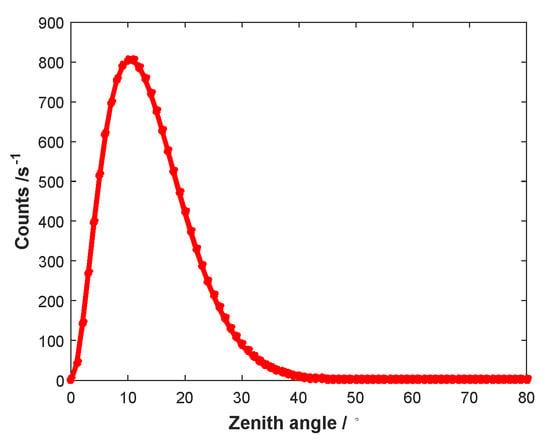
Figure 4.
Photon counts versus zenith angle.
The relationship between secure keys and satellite orbital altitude for different intensities of turbulence is shown in Figure 5. These curves show that under weak turbulence conditions (Cn2 = 10−17), the system can communicate with satellites at an orbital altitude of 619 km; under middle-intensity turbulence conditions (Cn2 = 10−15), the system can communicate with satellites at an orbital altitude of 466 km; and under strong turbulence conditions (Cn2 = 10−13), the system can communicate with satellites at an orbital altitude of 173 km. From these data, it can be seen that the communication distance between the offshore platform and the satellite QKD system decreases with an increase in turbulence intensity due to the influence of sea-surface atmospheric turbulence.
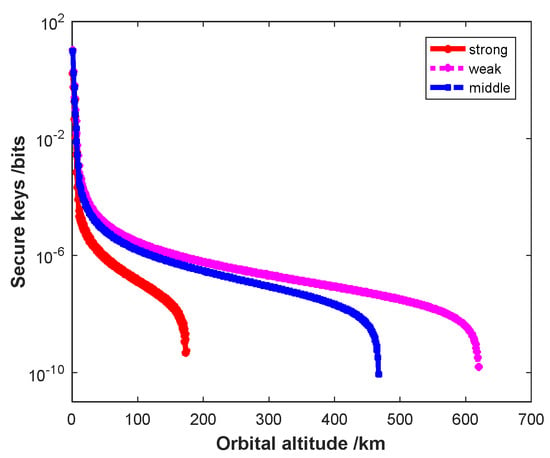
Figure 5.
Secure keys versus satellite orbit altitude.
Based on the above results, the system was optimized to ensure that the transmitting end could communicate with the receiving end on a satellite at an orbital altitude of 1000 km. Figure 6a shows the diagram of photons counts received versus satellite orbit altitude when the zenith angle is 15 degrees, Figure 6b shows a diagram of quantum BER (QBER) versus satellite orbit altitude for different turbulence intensities. It can be seen that the performances are seriously affected by strong turbulence. In strong turbulence, the photon counts are significantly lower, and the QBER performance significantly increases.
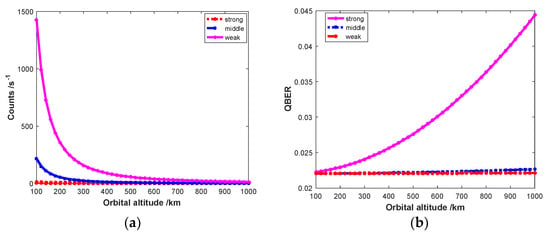
Figure 6.
Photon counts (a) and QBER (b) versus satellite orbital altitude at a 30° zenith angle.
When the zenith angle is 15 degrees, the curves in Figure 7a represent the relationship between photon counts by the system and satellite orbit altitude under different turbulence intensities, and the curves in Figure 7b represent the relationship between QBER and satellite orbit altitude under different turbulence intensities. When comparing the data in Figure 6 and Figure 7, it can be seen that under the same turbulence conditions, the photon counts by the system with a zenith angle of 15 degrees are higher than that with a zenith angle of 30 degrees. The performance of QBER under a zenith angle of 15 degrees is better than that under a zenith angle of 30 degrees, too. This is due to the fact that, at the same satellite orbital altitude, the larger the zenith angle, the longer the link distance, the greater the attenuation caused by the atmospheric turbulence, thus affecting photon counts.

Figure 7.
Photon counts (a) and QBER (b) versus satellite orbital altitude at a 15° zenith angle.
3.2. The Ship-to-Ship QKD System
In a ship-to-ship QKD system, the transmitter is fixed on a ship, and the receiver is fixed on another ship. Figure 8 shows a diagram of secure keys versus transmission distance under different intensity turbulence conditions. The transmission distances of the system are 32 km, 16 km, and 3 km under a weak turbulence, middle turbulence, and strong turbulence atmospheres, respectively. It can be seen that the performance of QKD is seriously affected by the atmospheric turbulence when it is transmitted horizontally at the sea surface, which leads to a sharp decrease in the QKD transmittable distance and secure keys with an increase in turbulence intensity.
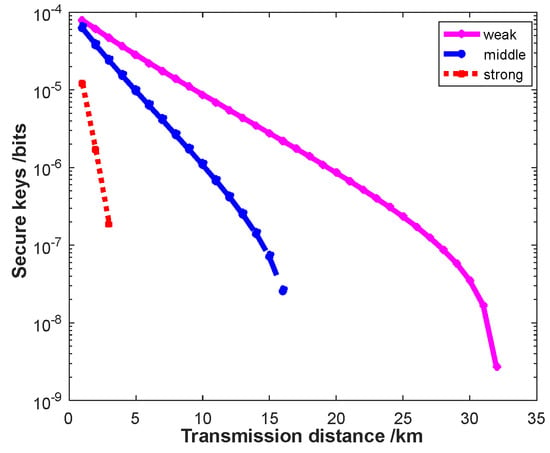
Figure 8.
Secure keys versus transmission distance.
Based on the above results, the QKD system’s coding rate with a horizontal transmission distance of 10 km was investigated. As shown in Figure 9, the number of received photons decreases sharply when the light is transmitted over a certain distance under sea-surface turbulence. Therefore, the QKD system can only transmit over a few kilometers under strong turbulence, and when the turbulence is strong enough, the signal cannot be received or encoded.
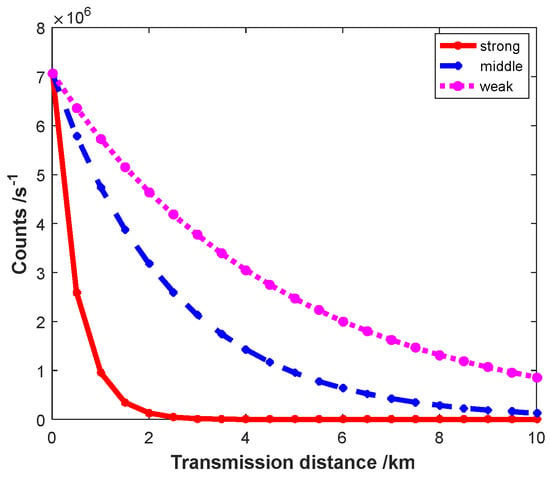
Figure 9.
Photon counts versus transmission distance.
4. Discussion
The findings of this study provide a theoretical basis for investigating the impact of atmospheric turbulence on ship-based QKD systems at sea surface, filling a significant gap in the existing literature. While previous studies have extensively explored the performance of satellite–ground QKD systems in the atmosphere, and classical optical communication in oceanic environments, the unique challenges posed by near sea-surface turbulence in maritime QKD scenarios have remained under-explored. Unlike studies focused on vertical satellite–ground links or horizontal underwater channels, we systematically quantify the impact of turbulence on satellite-to-ship (vertical) and ship-to-ship (horizontal) QKD configurations, revealing stark performance differences. For instance, horizontal ship-to-ship communication distances collapse from 32 km (weak turbulence) to 3 km (strong turbulence). In contrast, vertical satellite links exhibit altitude-dependent degradation patterns (such as secure key thresholds dropping from 619 km to 173 km). These results suggest that the performance of horizontal links is more susceptible to ocean turbulence than vertical links.
The results suggest several strategies for QKD deployment at sea:
- (1)
- Time optimization: By taking advantage of diurnal and nocturnal turbulence differences, QKD experiments can prioritize low turbulence periods (such as early morning) for long-range ship-to-satellite key exchanges.
- (2)
- Adaptive optics compensation: Quantized aiming error variance provides a design specification for an adaptive beam steering system to reduce turbulence-induced aiming losses.
- (3)
- Background light suppression technology: Reducing the impact of background light on quantum light performance enables daytime QKD experiments to be performed.
- (4)
- Hybrid network architecture deployment: Combining short-range ship-to-ship QKD (under moderate turbulence conditions) with satellite relay enables secure maritime mesh networks; this is, especially important for naval operations or offshore energy infrastructure.
While this study focuses on the BB84 protocol, extending the framework to measurement-device-independent QKD or continuous variable protocols may enhance its adaptability to turbulence. In addition, combining machine learning with real-time turbulence prediction and adaptive parameter tuning may further optimize performance in dynamic ocean environments. Overall, this work not only deepens our understanding of the impact of ocean turbulence on the performance of QKDs at sea, but also provides feasible insights for implementing robust quantum-safe communications on Earth.
5. Conclusions
Sea-surface atmospheric turbulence has a significant impact on the performances of a ship-based QKD, especially on the performances of ship-to-ship QKD systems, where strong turbulence can greatly reduce secure keys and horizontal transmission distances plummet from 32 km (weak turbulence) to 3 km (strong turbulence), or even become impossible to encode. Therefore, optical compensation, background light suppression, and coding protocol improvement should be used to obtain better performance in QKD experiments.
Author Contributions
Conceptualization, G.-Y.J.; methodology, G.-Y.J., X.-H.L., W.-D.Z. and Z.-A.W.; software, G.-Y.J.; validation, G.-Y.J.; formal analysis, G.-Y.J.; investigation, X.-H.L., W.-D.Z. and Z.-A.W.; resources, S.Z.; data curation, X.-H.L., Q.-M.Z. and P.-F.G.; writing—original draft preparation, G.-Y.J.; writing—review and editing, G.-Y.J.; supervision, Y.-P.L.; project administration, S.Z.; funding acquisition, Y.-P.L. All authors have read and agreed to the published version of the manuscript.
Funding
This research was funded by the Key Research and Development Program of Wuhan grant number 2025060102030013.
Institutional Review Board Statement
Not applicable.
Informed Consent Statement
Not applicable.
Data Availability Statement
The original contributions presented in this study are included in the article. Further inquiries can be directed to the corresponding author(s).
Conflicts of Interest
The authors declare no conflict of interest.
References
- Roger, T.; Singh, R.; Perumangatt, C.; Marangon, D.G.; Sanzaro, M.; Smith, P.R.; Woodward, R.I.; Shields, A.J. Real-time gigahertz free-space quantum key distribution within an emulated satellite overpass. Sci. Adv. 2023, 9, 5873. [Google Scholar]
- Li, Y.; Cai, W.Q.; Ren, J.G.; Wang, C.Z.; Yang, M.; Zhang, L.; Wu, H.Y.; Chang, L.; Wu, J.C.; Jin, B.; et al. Microsatellite-based real-time quantum key distribution. Nature 2025. [Google Scholar] [CrossRef] [PubMed]
- Bennett, C.H.; Brassard, G. Quantum cryptography: Public key distribution and coin tossing. In Proceedings of the IEEE International Conference on Computers, Systems, and Signal Processing, Bangalore, India, 10–12 December 1984; pp. 175–179. [Google Scholar]
- Bennett, C.H. Quantum cryptography using any two non-orthogonal states. Phys. Rev. Lett. 1992, 68, 3121. [Google Scholar] [CrossRef] [PubMed]
- Bonato, C.; Tomaello, A.; Da Deppo, V.; Naletto, G.; Villoresi, P. Feasibility of satellite quantum key distribution. New J. Phys. 2009, 11, 045017. [Google Scholar]
- Zedini, E.; Kammoun, A.; Soury, H.; Hamdi, M.; Alouini, M.S. Performance analysis of Dual-Hop underwater wireless optical communication systems over mixture exponential-generalized Gamma turbulence channels. IEEE Trans. Commun. 2020, 68, 5718–5731. [Google Scholar]
- Yi, X.; Djordjevic, I.B. Power spectrum of refractive-index fluctuations in turbulent ocean and its effect on optical scintillation. Opt. Express 2018, 26, 10188–10202. [Google Scholar] [CrossRef] [PubMed]
- Xu, G.; Lai, J. Scintillation index and BER performance for optical wave propagation in anisotropic underwater turbulence under the effect of eddy diffusivity ratio. Appl. Opt. 2020, 59, 2551–2558. [Google Scholar] [CrossRef] [PubMed]
- Gokce, M.C.; Baykal, Y.; Ata, Y. M-ary phase shift keying-subcarrier intensity modulation performance in strong oceanic turbulence. Opt. Eng. 2019, 58, 056105. [Google Scholar]
- Baykal, Y.; Ata, Y.; Gokce, M.C. Performance of M-ary pulse position modulated optical wireless communications systems in the marine atmosphere. Appl. Opt. 2021, 60, 2166–2170. [Google Scholar] [PubMed]
- Fu, Y.Q.; Duan, Q.; Zhou, L. Performance of underwater wireless optical communication system in Gamma Gamma strong oceanic turbulence with pointing error. Infrared Laser Eng. 2020, 49, 0203013. [Google Scholar]
- Zhang, J.L.; He, H.Y.; Nie, H.; Qiu, X.F.; Li, J.Q.; Yang, Y.; He, F.T. Performance of Double-headed Pulse Interval Modulated Wireless Optical Communication System in Anisotropic Ocean Turbulence. Acta Photonica Sin. 2022, 51, 87–99. [Google Scholar]
- Azuma, K.; Economou, S.E.; Elkouss, D.; Hilaire, P.; Jiang, L.; Lo, H.K.; Tzitrin, I. Quantum repeaters: From quantum networks to the quantum internet. Rev. Mod. Phys. 2023, 95, 045006. [Google Scholar]
- Chen, Y.A.; Zhang, Q.; Chen, T.Y.; Cai, W.Q.; Liao, S.K.; Zhang, J.; Chen, K.; Yin, J.; Ren, J.G.; Chen, Z.; et al. An integrated space-to-ground quantum communication network over 4600 kilometers. Nature 2021, 589, 214–219. [Google Scholar] [CrossRef] [PubMed]
- Chen, D.; Zhang, B.; Li, H.; Rao, R. Analysis of the influence of marine atmospheric turbulence to the accuracy of laser tracking system. Opt. Technol. 2009, 35, 80–82. [Google Scholar]
- Du, X.; Ding, G.X.; Du, H.; Wang, S.; Feng, H. Transmission characteristics of Hermitian-Gaussian beams in marine turbulence. J. Opt. 2023, 43, 39–46. [Google Scholar]
- He, P.L.; Wu, D.; Wang, K.H.; Li, K.N. Numerical simulation and generation mechanism of a turbulence event in a near-cloud area along the southeast coast. Arid Meteorol. 2024, 42, 922–933. [Google Scholar]
- Meyer-Scott, E.; Yan, Z.; MacDonald, A.; Bourgoin, J.P.; Hübel, H.; Jennewein, T. How to implement decoy-state quantum key distribution for satellite uplink with 50-dB channel loss. Phys. Rev. A 2011, 84, 062326. [Google Scholar]
Disclaimer/Publisher’s Note: The statements, opinions and data contained in all publications are solely those of the individual author(s) and contributor(s) and not of MDPI and/or the editor(s). MDPI and/or the editor(s) disclaim responsibility for any injury to people or property resulting from any ideas, methods, instructions or products referred to in the content. |
© 2025 by the authors. Licensee MDPI, Basel, Switzerland. This article is an open access article distributed under the terms and conditions of the Creative Commons Attribution (CC BY) license (https://creativecommons.org/licenses/by/4.0/).